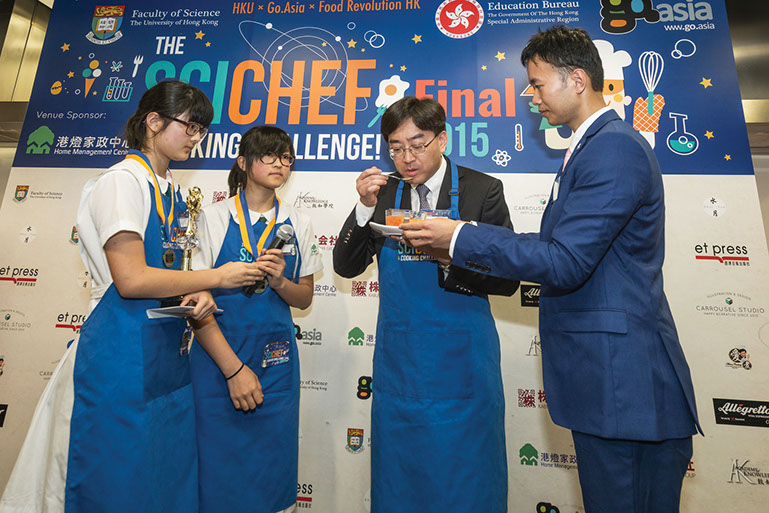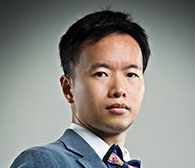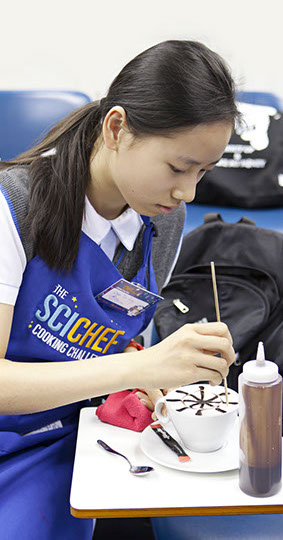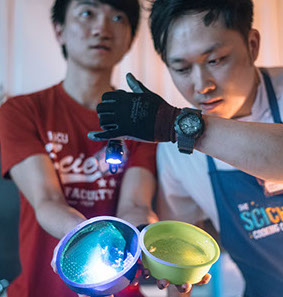
Secretary for Food and Health Dr Ko Wing-man (second from right) tastes the dish prepared by the champions.
JUNIOR CHEFS
MASTER SCIENCE
A cooking competition organised by the Faculty of Science encouraged junior secondary school students to apply scientific principles in their daily lives.


![]() Our goal as a faculty is to increase scientific literacy, but not in the traditional way of going to a laboratory and listening to lectures.
Our goal as a faculty is to increase scientific literacy, but not in the traditional way of going to a laboratory and listening to lectures. ![]()
Dr Benny Ng
The pursuit of science conjures up images of laboratories, test tubes and white coats – things removed from everyday life. But Dr Benny Ng of the Faculty of Science has been spearheading efforts to turn that idea on its head and show people how to see the science all around them.

A challenger is working on her latte art.
In 2013 and 2014 he organised the Science and Art Crossover Project to inspire students to see the science in such things as sunflower patterns, origami and animation. This year he led the SciChef Cooking Challenge, in which junior secondary school students had to select a recipe, find a way to improve it, explain the science behind their efforts to a panel of judges, and cook up the dish. They were judged on both scientific knowledge and taste.
“Our goal as a faculty is to increase scientific literacy, but not in the traditional way of going to a laboratory and listening to lectures. We wanted the students to relate science to their daily lives, to something they can do at home,” he said.
“We also wanted them to be creative and work on their teamwork, communication and leadership skills, which are not things they learn from the traditional curriculum.”
The event was organised in two parts. Eighty-eight applications were received from 28 schools and the top 15 were invited to the semi-finals where they had to describe their proposed recipe and the scientific ideas that they were exploring. For instance, one team proposed a soufflé and detailed their experimentation, which involved more than 20 attempts before they got the soufflé to rise.

Chef Perry Lau from Shui Yue demonstrates glow-in-the-dark sugar crystal ball.
Winning with polymerisation
Twelve teams were selected from that group for the final, where they actually prepared their dishes. They had 60 minutes and employed all kinds of scientific methods. For instance, one team used the sous vide method to cook chicken, which was vacuum-packed before being poached at a constant temperature of 63 degrees Celsius in a water bath – which, incidentally, had come from a laboratory.
The winning entry, called ‘Amazing Dessert from Seaweed’, involved the preparation of five dessert jellies using a mixture of algae from seaweed extracts and calcium. The combination helped the jelly to set through the process of polymerisation.
The competition was supported by the Hong Kong Electric Home Management Centre, DotAsia Organisation and HKU’s Knowledge Exchange Fund. Guest chefs gave demonstrations and the Secretary for Food and Health, Dr Ko Wing-man, BBS, JP, attended the closing ceremony in May.
Next up: the SMArt programme 2016, also aimed at secondary school students, which Dr Ng said would incorporate science, mathematics and art. For more information and registration, please go to http://www.scifac.hku.hk/smart
Back

